Antoine Marot
RTE
RL2Grid: Benchmarking Reinforcement Learning in Power Grid Operations
Mar 29, 2025Abstract:Reinforcement learning (RL) can transform power grid operations by providing adaptive and scalable controllers essential for grid decarbonization. However, existing methods struggle with the complex dynamics, aleatoric uncertainty, long-horizon goals, and hard physical constraints that occur in real-world systems. This paper presents RL2Grid, a benchmark designed in collaboration with power system operators to accelerate progress in grid control and foster RL maturity. Built on a power simulation framework developed by RTE France, RL2Grid standardizes tasks, state and action spaces, and reward structures within a unified interface for a systematic evaluation and comparison of RL approaches. Moreover, we integrate real control heuristics and safety constraints informed by the operators' expertise to ensure RL2Grid aligns with grid operation requirements. We benchmark popular RL baselines on the grid control tasks represented within RL2Grid, establishing reference performance metrics. Our results and discussion highlight the challenges that power grids pose for RL methods, emphasizing the need for novel algorithms capable of handling real-world physical systems.
A Pioneering Roadmap for ML-Driven Algorithmic Advancements in Electrical Networks
May 28, 2024Abstract:To advance control, operation and planning tools of electrical networks with ML is not straightforward. 110 experts were surveyed showing where and how ML algorithmis could advance. This paper assesses this survey and research environment. Then it develops an innovation roadmap that helps align our research community towards a goal-oriented realisation of the opportunities that AI upholds. This paper finds that the R\&D environment of system operators (and the surrounding research ecosystem) needs adaptation to enable faster developments with AI while maintaining high testing quality and safety. This roadmap may interest research centre managers in system operators, academics, and labs dedicated to advancing the next generation of tooling for electrical networks.
AI Competitions and Benchmarks: towards impactful challenges with post-challenge papers, benchmarks and other dissemination actions
Dec 14, 2023Abstract:Organising an AI challenge does not end with the final event. The long-lasting impact also needs to be organised. This chapter covers the various activities after the challenge is formally finished. The target audience of different post-challenge activities is identified. The various outputs of the challenge are listed with the means to collect them. The main part of the chapter is a template for a typical post-challenge paper, including possible graphs as well as advice on how to turn the challenge into a long-lasting benchmark.
Managing power grids through topology actions: A comparative study between advanced rule-based and reinforcement learning agents
Apr 17, 2023Abstract:The operation of electricity grids has become increasingly complex due to the current upheaval and the increase in renewable energy production. As a consequence, active grid management is reaching its limits with conventional approaches. In the context of the Learning to Run a Power Network challenge, it has been shown that Reinforcement Learning (RL) is an efficient and reliable approach with considerable potential for automatic grid operation. In this article, we analyse the submitted agent from Binbinchen and provide novel strategies to improve the agent, both for the RL and the rule-based approach. The main improvement is a N-1 strategy, where we consider topology actions that keep the grid stable, even if one line is disconnected. More, we also propose a topology reversion to the original grid, which proved to be beneficial. The improvements are tested against reference approaches on the challenge test sets and are able to increase the performance of the rule-based agent by 27%. In direct comparison between rule-based and RL agent we find similar performance. However, the RL agent has a clear computational advantage. We also analyse the behaviour in an exemplary case in more detail to provide additional insights. Here, we observe that through the N-1 strategy, the actions of the agents become more diversified.
Reinforcement learning for Energies of the future and carbon neutrality: a Challenge Design
Jul 21, 2022


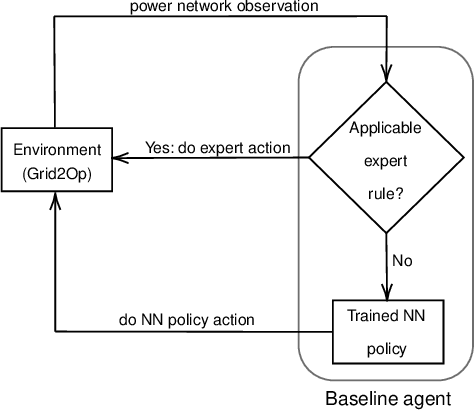
Abstract:Current rapid changes in climate increase the urgency to change energy production and consumption management, to reduce carbon and other green-house gas production. In this context, the French electricity network management company RTE (R{\'e}seau de Transport d'{\'E}lectricit{\'e}) has recently published the results of an extensive study outlining various scenarios for tomorrow's French power management. We propose a challenge that will test the viability of such a scenario. The goal is to control electricity transportation in power networks, while pursuing multiple objectives: balancing production and consumption, minimizing energetic losses, and keeping people and equipment safe and particularly avoiding catastrophic failures. While the importance of the application provides a goal in itself, this challenge also aims to push the state-of-the-art in a branch of Artificial Intelligence (AI) called Reinforcement Learning (RL), which offers new possibilities to tackle control problems. In particular, various aspects of the combination of Deep Learning and RL called Deep Reinforcement Learning remain to be harnessed in this application domain. This challenge belongs to a series started in 2019 under the name "Learning to run a power network" (L2RPN). In this new edition, we introduce new more realistic scenarios proposed by RTE to reach carbon neutrality by 2050, retiring fossil fuel electricity production, increasing proportions of renewable and nuclear energy and introducing batteries. Furthermore, we provide a baseline using state-of-the-art reinforcement learning algorithm to stimulate the future participants.
Learning to run a power network with trust
Oct 21, 2021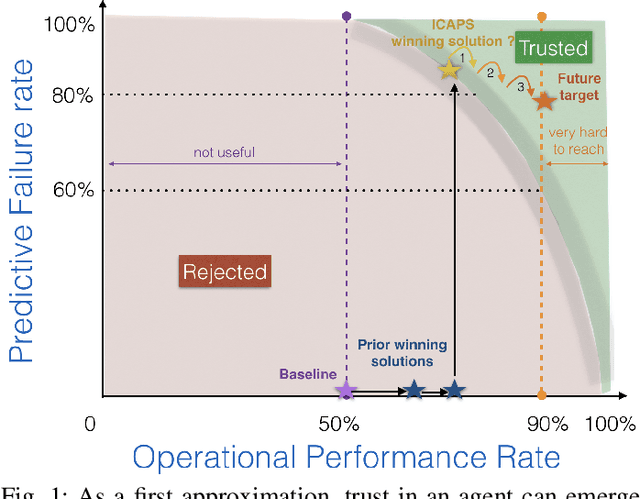
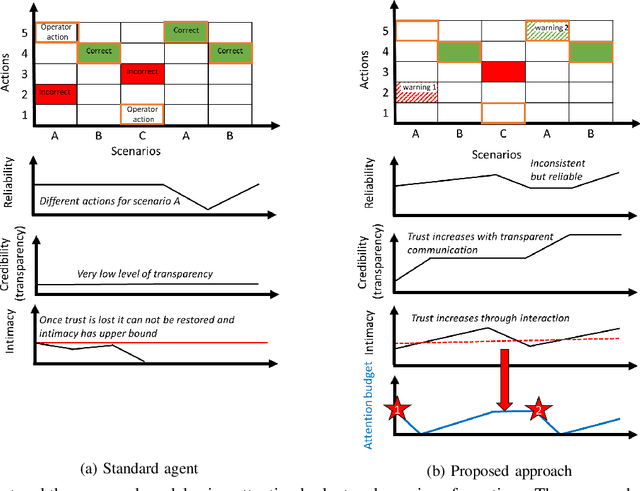
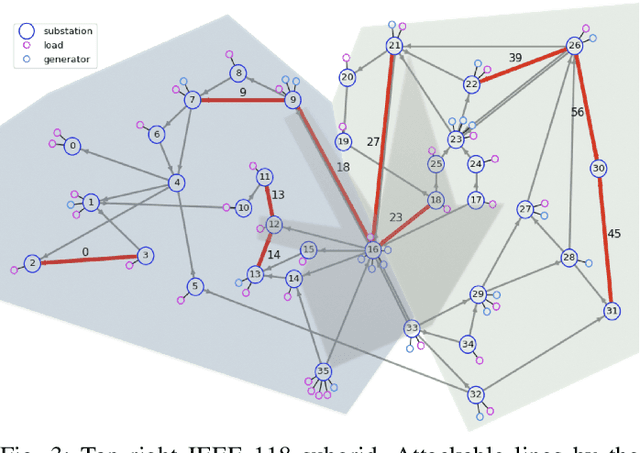
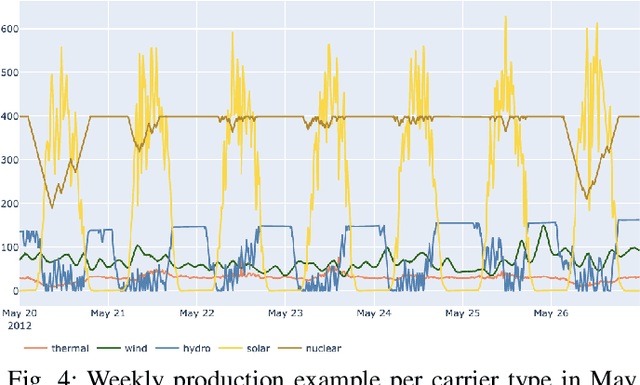
Abstract:Artificial agents are promising for realtime power system operations, particularly, to compute remedial actions for congestion management. Currently, these agents are limited to only autonomously run by themselves. However, autonomous agents will not be deployed any time soon. Operators will still be in charge of taking action in the future. Aiming at designing an assistant for operators, we here consider humans in the loop and propose an original formulation for this problem. We first advance an agent with the ability to send to the operator alarms ahead of time when the proposed actions are of low confidence. We further model the operator's available attention as a budget that decreases when alarms are sent. We present the design and results of our competition "Learning to run a power network with trust" in which we benchmark the ability of submitted agents to send relevant alarms while operating the network to their best.
Learning to run a Power Network Challenge: a Retrospective Analysis
Mar 02, 2021



Abstract:Power networks, responsible for transporting electricity across large geographical regions, are complex infrastructures on which modern life critically depend. Variations in demand and production profiles, with increasing renewable energy integration, as well as the high voltage network technology, constitute a real challenge for human operators when optimizing electricity transportation while avoiding blackouts. Motivated to investigate the potential of Artificial Intelligence methods in enabling adaptability in power network operation, we have designed a L2RPN challenge to encourage the development of reinforcement learning solutions to key problems present in the next-generation power networks. The NeurIPS 2020 competition was well received by the international community attracting over 300 participants worldwide. The main contribution of this challenge is our proposed comprehensive Grid2Op framework, and associated benchmark, which plays realistic sequential network operations scenarios. The framework is open-sourced and easily re-usable to define new environments with its companion GridAlive ecosystem. It relies on existing non-linear physical simulators and let us create a series of perturbations and challenges that are representative of two important problems: a) the uncertainty resulting from the increased use of unpredictable renewable energy sources, and b) the robustness required with contingent line disconnections. In this paper, we provide details about the competition highlights. We present the benchmark suite and analyse the winning solutions of the challenge, observing one super-human performance demonstration by the best agent. We propose our organizational insights for a successful competition and conclude on open research avenues. We expect our work will foster research to create more sustainable solutions for power network operations.
Adversarial Training for a Continuous Robustness Control Problem in Power Systems
Jan 14, 2021



Abstract:We propose a new adversarial training approach for injecting robustness when designing controllers for upcoming cyber-physical power systems. Previous approaches relying deeply on simulations are not able to cope with the rising complexity and are too costly when used online in terms of computation budget. In comparison, our method proves to be computationally efficient online while displaying useful robustness properties. To do so we model an adversarial framework, propose the implementation of a fixed opponent policy and test it on a L2RPN (Learning to Run a Power Network) environment. That environment is a synthetic but realistic modeling of a cyber-physical system accounting for one third of the IEEE 118 grid. Using adversarial testing, we analyze the results of submitted trained agents from the robustness track of the L2RPN competition. We then further assess the performance of those agents in regards to the continuous N-1 problem through tailored evaluation metrics. We discover that some agents trained in an adversarial way demonstrate interesting preventive behaviors in that regard, which we discuss.
Towards an AI assistant for human grid operators
Dec 03, 2020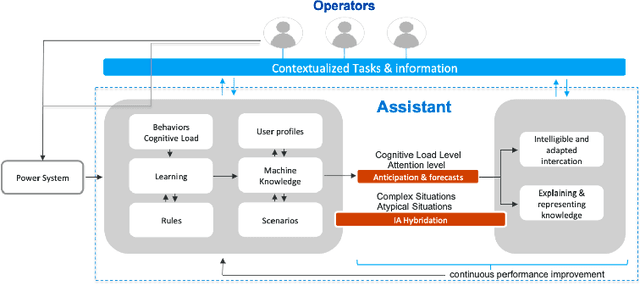

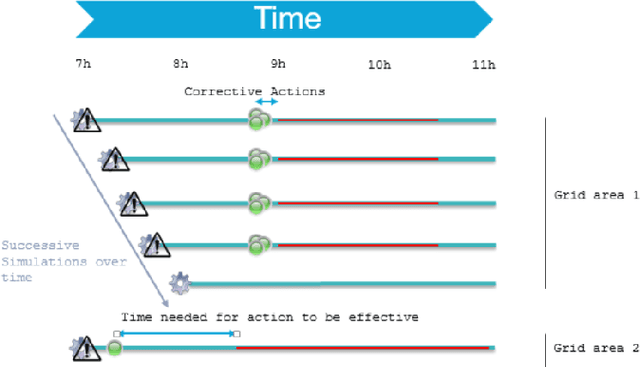
Abstract:Power systems are becoming more complex to operate in the digital age. As a result, real-time decision-making is getting more challenging as the human operator has to deal with more information, more uncertainty, more applications and more coordination. While supervision has been primarily used to help them make decisions over the last decades, it cannot reasonably scale up anymore. There is a great need for rethinking the human-machine interface under more unified and interactive frameworks. Taking advantage of the latest developments in Human-machine Interactions and Artificial intelligence, we share the vision of a new assistant framework relying on an hypervision interface and greater bidirectional interactions. We review the known principles of decision-making that drives the assistant design and supporting assistance functions we present. We finally share some guidelines to make progress towards the development of such an assistant.
Exploring grid topology reconfiguration using a simple deep reinforcement learning approach
Nov 26, 2020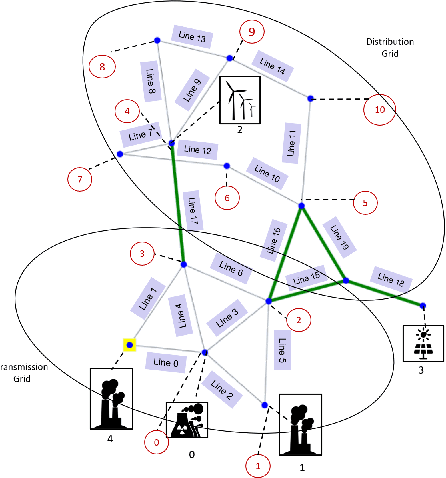
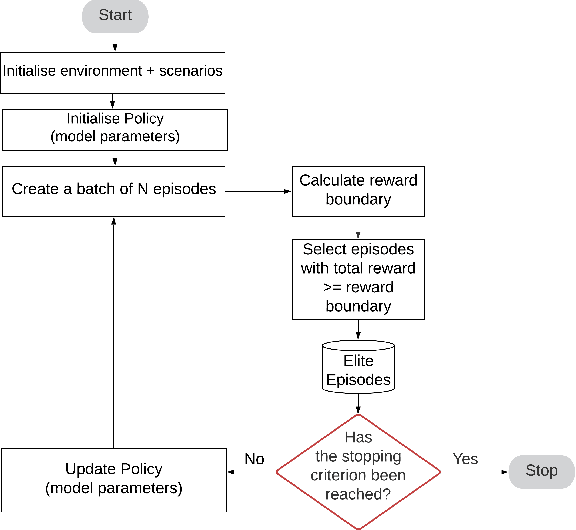
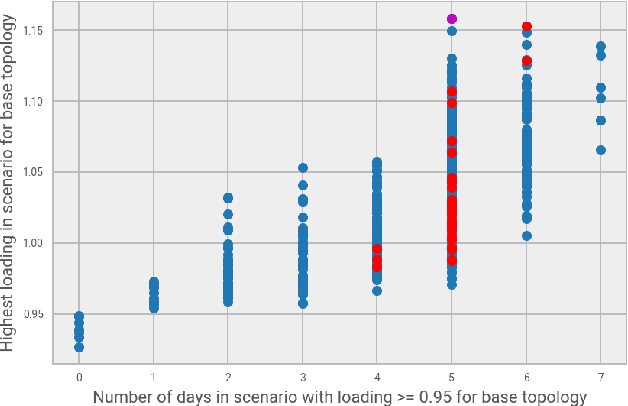
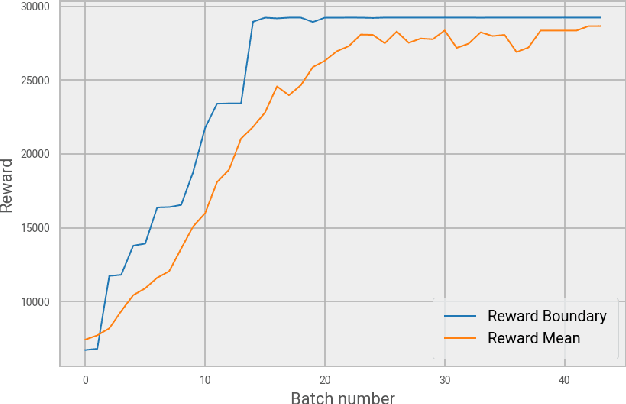
Abstract:System operators are faced with increasingly volatile operating conditions. In order to manage system reliability in a cost-effective manner, control room operators are turning to computerised decision support tools based on AI and machine learning. Specifically, Reinforcement Learning (RL) is a promising technique to train agents that suggest grid control actions to operators. In this paper, a simple baseline approach is presented using RL to represent an artificial control room operator that can operate a IEEE 14-bus test case for a duration of 1 week. This agent takes topological switching actions to control power flows on the grid, and is trained on only a single well-chosen scenario. The behaviour of this agent is tested on different time-series of generation and demand, demonstrating its ability to operate the grid successfully in 965 out of 1000 scenarios. The type and variability of topologies suggested by the agent are analysed across the test scenarios, demonstrating efficient and diverse agent behaviour.
 Add to Chrome
Add to Chrome Add to Firefox
Add to Firefox Add to Edge
Add to Edge